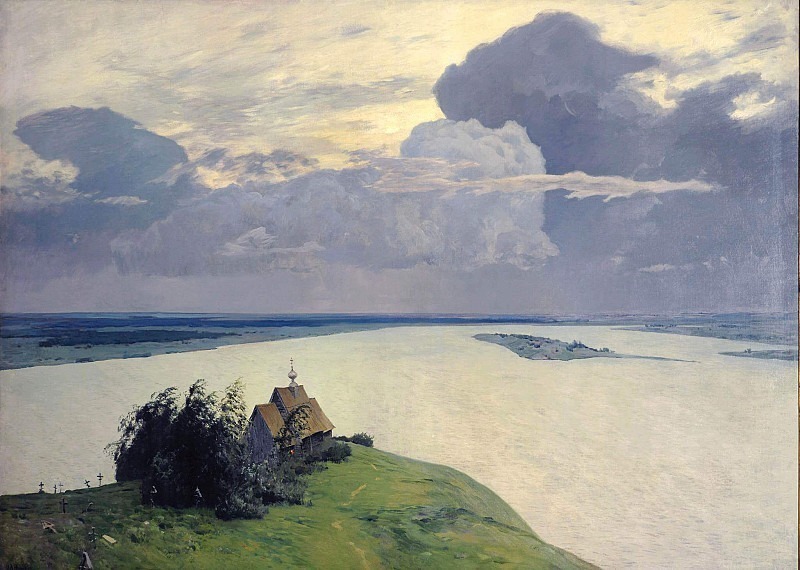Over eternal rest Isaac Ilyich Levitan (1860-1900)
Isaac Ilyich Levitan – Over eternal rest
Edit attribution
Download full size: 2048×1459 px (0,2 Mb)
Painter: Isaac Ilyich Levitan
Location: The State Tretyakov Gallery, Moscow (Государственная Третьяковская галерея).
Isaac Levitan’s painting "Above Eternal Rest" is one of the gems of the artist’s work. Art historians refer this work to a trilogy of his paintings, believing that the first is At the Omita, the second is Vladimirka, and the third is Above Eternal Rest. The picture was painted from nature, which was an old wooden church near Vyshny Volochok (a small town in Tver province). The artistic canvas depicts the high shore of the lake, a vast beautiful sky at sunset with pale purple clouds and a small wooden church, standing lonely on the shore.
Description of Isaac Levitan’s painting "Above Eternal Rest
Isaac Levitan’s painting "Above Eternal Rest" is one of the gems of the artist’s work. Art historians refer this work to a trilogy of his paintings, believing that the first is At the Omita, the second is Vladimirka, and the third is Above Eternal Rest.
The picture was painted from nature, which was an old wooden church near Vyshny Volochok (a small town in Tver province).
The artistic canvas depicts the high shore of the lake, a vast beautiful sky at sunset with pale purple clouds and a small wooden church, standing lonely on the shore. Next to the church is an old cemetery with wood crosses that have grown crooked with time.
The viewer seems to feel all the harsh beauty of Russian nature, the coldness of its winds, the power of the rivers and the immense distance of the fields.
And in this unpretentious subject there is a profound philosophy of life and death, the foundations of the Russian folk spirit. It’s a reflection on God, life and man, his place in the world, memory and the future. The image of the little wooden church is an image of man himself, seeking God’s truth on earth, striving for light, for life, for love, but often not finding them. It is a painting about hope, about the transience of life, about the fact that each of us feels his connection to something majestic and grandiose, whose name for us is found in terms of religious rather than material concepts.
There is also a sense of subtle longing and loneliness, but there is also much faith, faith in the future joy of heaven. There is also a sense of peace and grandeur of the world created by the Creator.
But the beauty of Levitan landscapes is that each viewer can see in his paintings something different. But they do not leave anyone indifferent, as can not leave a person indifferent to his homeland - quiet, majestic and beautiful.
Кому понравилось
Пожалуйста, подождите
На эту операцию может потребоваться несколько секунд.
Информация появится в новом окне,
если открытие новых окон не запрещено в настройках вашего браузера.
You need to login
Для работы с коллекциями – пожалуйста, войдите в аккаунт (open in new window).




















You cannot comment Why?
The painting depicts a vast, wide river flowing through a landscape under a dramatic sky. In the foreground, on a grassy hill to the left, stands a small, weathered wooden church with a single dome, bathed in soft light. Trees with wind-swept branches surround the church, and a scattering of simple crosses mark a small graveyard on the slope leading down to the river. The river itself is a prominent feature, its surface reflecting the light and the muted colors of the sky. In the distance, the river curves, with a small island dotted with buildings visible in its expanse. The shoreline on the far side is lined with dark green foliage, separating the river from a distant, hazy horizon.
The sky is filled with imposing, dark grey clouds, tinged with yellow and white where the sun attempts to break through. These clouds create a sense of foreboding or impending change, contrasting with the serene, reflective quality of the water.
The subtexts of this painting can be interpreted on several levels. The presence of the church and graveyard on a hilltop overlooking the river and distant landscape strongly suggests themes of spirituality, mortality, and the enduring presence of faith amidst the vastness of nature and time. The weathered church itself speaks of history and resilience, a symbol of human presence and belief in a permanent, eternal realm.
The expansive river can represent the flow of life, time, and perhaps the journey of the soul. The island in the distance might symbolize a destination or a spiritual sanctuary. The dramatic sky, with its gathering storm clouds, could allude to challenges, the ephemeral nature of earthly existence, or the power of divine forces. Yet, the light breaking through suggests hope, salvation, or transcendence.
The title, Over Eternal Rest, directly points to themes of death, peace, and the afterlife. The scene evokes a sense of quiet contemplation on the human condition, our place in the universe, and the ultimate destiny of the soul. It is a landscape that is simultaneously beautiful and somber, natural and spiritual, inviting the viewer to reflect on life, death, and what lies beyond.